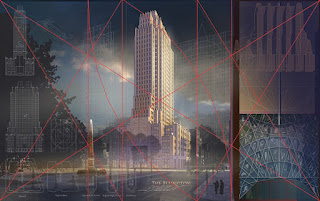COLOR DEMONSTRATION
Long ago I created this tiny pastel sketch of a church. I called it “Burning Church” for obvious reasons and filed it away.
Years later I was playing with ideas for “landmarks” along Broadway in New York City, and realized that my “Burning Church” might work on a site at the north end of Manhattan on 170th Street.
In designing the church I ran with a simplified gothic style with a blank base raising the sanctuary above the street level.
I then built an Autocad 3D model and tried out a number of viewpoints. This hidden line view was chosen for the final drawing.
This magic marker sketch gives a preliminary idea of the values I was aiming for.
A base drawing was produced using freehand ink on mylar.
The final drawing was 30” x 40”, so there was plenty of room for detail and texture.
Reproduced above is a color wheel. It shows the full range of colors going around the circumference, with saturation going from the center of the circle (desaturation = grey) to full color saturation at the circle edge. This is fully discussed on the outstanding “Gurney Journey” blog.
The original “Burning Church” sketch uses a very tight range of yellows and browns marked by the diamond shape of the color wheel. The sketch derives its strength from the limited palette.
The last color sketch above and accompanying color wheel show a complimentary palette ranging from yellow to blue. The combination of color contrast and value contrast makes the tower pop out strongly.
The last color sketch above and color wheel show an orange to grey-green palette. The color contrast is less strong, and the value contrast is created with a tower running from light on dark at the bottom to dark on light at the top. I’ve always loved the red-orange contrast with a grey-green sky; it reminds me of a portrait trick of contrasting warm flesh against a grey-green background.
The two sketches above have low saturation color palettes. Essentially, they are low contrast grey studies with pastel tone here and there.
The strong blue and yellow sketch above is going in the right direction, but seems a little bit too simple.
By adding a graded reddish tint top and bottom I pushed the focus to the center of the tower suggesting a cross composition.
The sketch above was done full size with pastel and pencil to study the detailed coloring of the church entry.
And here is the final art (30” x 40”). Note the darkened foreground and sky which adds to the drama and makes an excellent background for the white line elevations and plans. The final was done with transparent ink airbrushed on a photographic print of the ink line drawing. The title was done with white acrylic applied with (tiny) brushes. The ghosted plans/elevations/sections and quotes were color pencil.
Detail at the bottom of the painting.
Detail at the top.


































































